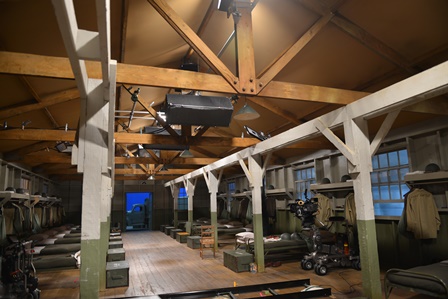The barracks set at Sydney's Fox Studios. (Photo credit: Jacinta Leong).
Crewing up in the middle of 2015, director Mel Gibson and producer Bill Mechanic were attracted to production designer Barry Robison's experience down under.
Robison, whose mother was born in Fremantle, first worked in Australia on Jodie Foster’s Nim's Island in 2007.
“It was summer and it was gorgeous and [we were] out in the Whitsundays, so I fell in love with that part of the country very quickly,” he tells IF.
“Right on the heels of that I was asked to do Wolverine down in Sydney, and during that I realised I could get my Australian citizenship. I finished that process on Narnia: The Voyage of the Dawn Treader.”
Robison’s dual citizenship, he admits, “certainly factored in to why I got Hacksaw, because it was a tight budget.”
Once he got the gig, Robison had a freewheeling chat with Gibson, whose approach he describes as “a little old school”.
“He wants to see a lot of reference photos and what-not, so I went down to New Orleans to the World War II Museum, which is an amazing resource and started doing my [research]. And while I was in New Orleans, I went into a book store and I found a fantastic book of Kodachrome images from the thirties and forties and they were just phenomenal. Very crisp but really lush colours, and I talked to Mel about using those images as a basis for Virginia.”
In the film’s first half, set in Virginia and a Kentucky barracks, Robison decided on a colour palette of green tones and greys and beiges, only deviating coming when Desmond is put into a prison cell.
“It was about the only time in the movie that I went a little more theatrical. I had gone to Europe earlier in the year and had seen some Eastern European monk cells and I went to Mel and I said, ‘I want to do the prison cell as a monk cell for Desmond'.”
Perhaps unsurprisingly for a filmmaker fond of the devotional image, Gibson approved.
“I changed the colour palette from the greens and beiges to black and white just because of where Desmond was at that point, emotionally. There was no grey for him. So I split the cell on a horizontal line.”
Moving to Bringelly for the battle scenes, Robison was aided by Gibson’s experience in staging large-scale action.
“Mel was extremely clear on what he wanted from day one,” says the designer. “He kept talking about the ugly intensity of war.”
The production was able to use the main location, a dairy farm, for a number of scenes, not just those set on the battlefield.
“We used it for a Japanese farm house, the battlefield headquarters and roads in and out of the battlefield to Okinawa. It was really amazing what we could. The local council was so generous out there.”
Battlefields tunnels under construction at Fox Studios. (Photo credit: Jacinta Leong).
Two-thirds of the film’s scenes set in Okinawa were done on location, estimates Robison: “You know, flame throwers and blowing up bunkers and all of that.”
The team retreated to the more controlled environment of a Fox Studios soundstage to shoot intimate scenes featuring actors in foxholes, plus sequences involving underground tunnels, which were built at Fox.
With six Oscar nominations, including for Best Picture, Hacksaw Ridge has been roundly embraced by the Academy, whose members Robison describes as “very hard (laughs). You have no idea.”
Robison attended the first Academy screening and was blown away by the reception, and moved to see Gibson getting credit for his work.
“I mean, he's been in the penalty box for almost ten years. And I think that's time enough. He's not a director that asks for respect but I will tell you, you want to give it to him. You want to give him the respect because he's so knowledgeable, he's so quiet, he's so focused. If he asked me to jump out of an aeroplane with no parachute, I would do it (laughs).”
The Icon production has rung up $65 million in North America and around $100 million internationally since its release in early November, and Robison is gratified that the work of his Aussie design team is being seen.
“I'm so pleased and proud of what they were able to give me. We've been together for almost nine years, on and off, and that's really something. That's a testament to my team and their belief in our ability together to create something pretty fantastic.”


